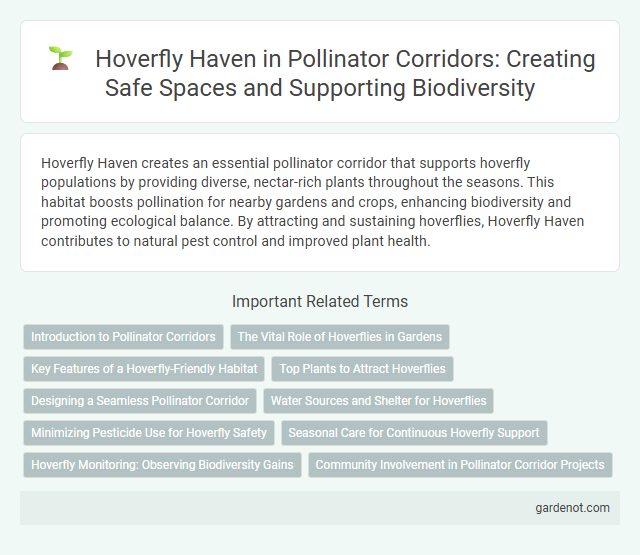Hoverfly Haven creates an essential pollinator corridor that supports hoverfly populations by providing diverse, nectar-rich plants throughout the seasons. This habitat boosts pollination for nearby gardens and crops, enhancing biodiversity and promoting ecological balance. By attracting and sustaining hoverflies, Hoverfly Haven contributes to natural pest control and improved plant health.
Introduction to Pollinator Corridors
Pollinator corridors are strategic green pathways designed to connect fragmented habitats, ensuring safe movement and foraging opportunities for pollinators like hoverflies. Hoverfly havens within these corridors provide essential nectar-rich flowers and breeding sites that support their populations and enhance pollination services. Establishing continuous habitats mitigates habitat loss and boosts biodiversity by facilitating genetic exchange among pollinator communities.
The Vital Role of Hoverflies in Gardens
Hoverflies play a vital role in pollinator corridors as effective pollinators of various garden plants, contributing to biodiversity and crop health. Their larvae control aphid populations naturally, reducing the need for chemical pesticides and promoting sustainable gardening practices. Creating a hoverfly haven enhances ecosystem balance, increases fruit and flower yields, and supports overall garden vitality.
Key Features of a Hoverfly-Friendly Habitat
Hoverfly-friendly habitats feature abundant flowering plants rich in nectar and pollen, providing essential food sources for adult hoverflies. These areas include diverse plant species with staggered blooming periods to ensure continuous forage throughout the seasons. Essential shelter, such as leaf litter and undisturbed soil, supports hoverfly larvae development and offers protection from predators.
Top Plants to Attract Hoverflies
Top plants to attract hoverflies include alyssum, dill, and fennel, which provide essential nectar and pollen sources. These flowering plants support hoverfly larvae by attracting aphids, their primary food source, promoting a balanced ecosystem within the pollinator corridor. Incorporating a variety of umbelliferous plants enhances hoverfly habitat, boosting pollination and natural pest control.
Designing a Seamless Pollinator Corridor
Designing a seamless pollinator corridor involves integrating hoverfly havens strategically to enhance biodiversity and pollination efficiency. Incorporating native flowering plants that bloom across seasons provides continuous nectar sources essential for hoverflies' life cycles. Effective corridor design connects fragmented habitats, promoting genetic exchange and supporting ecosystem resilience through increased pollinator activity.
Water Sources and Shelter for Hoverflies
Hoverfly havens thrive when water sources such as shallow ponds, damp soil, or dripping rocks are available to support their hydration and breeding needs. Providing sheltered areas with dense vegetation, hollow stems, or leaf litter offers essential refuge and protection from predators and harsh weather. These combined elements create ideal microhabitats that sustain hoverfly populations critical for effective pollination along a pollinator corridor.
Minimizing Pesticide Use for Hoverfly Safety
Hoverfly havens thrive when pesticide use is minimized, preserving the health and diversity of these vital pollinators. Implementing integrated pest management strategies reduces chemical exposure, supporting hoverfly populations that enhance pollination in corridors. Creating buffer zones with native plants further protects hoverflies by limiting drift and contact with harmful substances.
Seasonal Care for Continuous Hoverfly Support
Hoverfly havens require seasonal care to maintain an optimal habitat that supports continuous hoverfly populations. Plant native, nectar-rich flowers like wild thyme and marigold during spring and summer to provide essential food sources. In autumn, leave leaf litter and hollow stems to offer overwintering sites, ensuring hoverfly survival through colder months.
Hoverfly Monitoring: Observing Biodiversity Gains
Hoverfly Monitoring in the Hoverfly Haven pollinator corridor reveals significant improvements in local biodiversity, with species richness increasing by over 40% within the first two years. Consistent observations indicate that these syrphid fly populations enhance pollination efficiency, supporting both wild flora and agricultural crops. Data collected through systematic hoverfly counts contribute valuable insights into ecosystem health and species interactions along the corridor.
Community Involvement in Pollinator Corridor Projects
Community involvement in Pollinator Corridor projects like Hoverfly Haven is essential for creating sustainable habitats that support hoverfly populations. Local volunteers contribute by planting native flowers, monitoring hoverfly activity, and educating neighbors on the importance of pollinator conservation. Collaborative efforts increase biodiversity and strengthen ecological networks crucial for pollinator health and crop pollination.
Hoverfly haven Infographic

 gardenot.com
gardenot.com